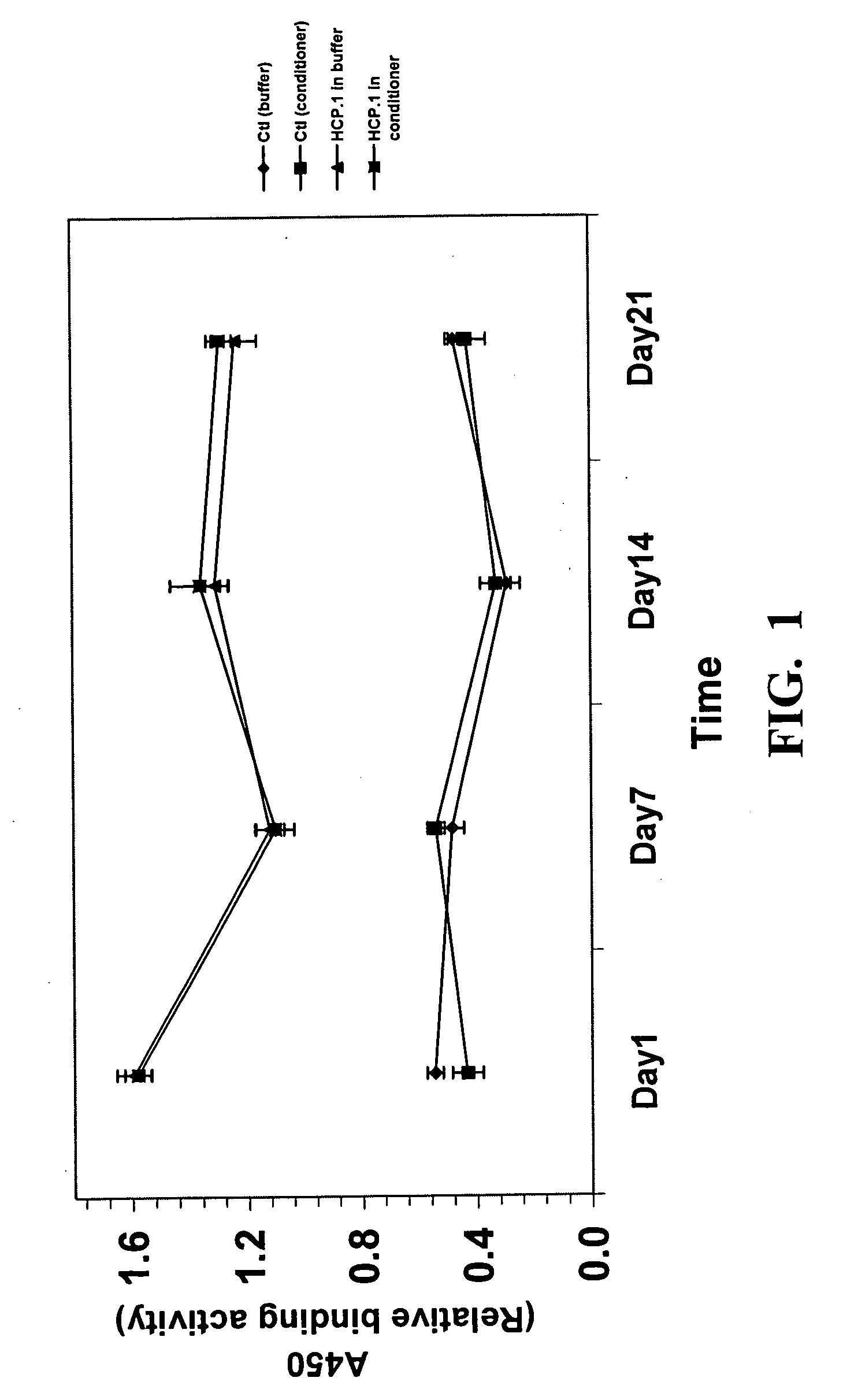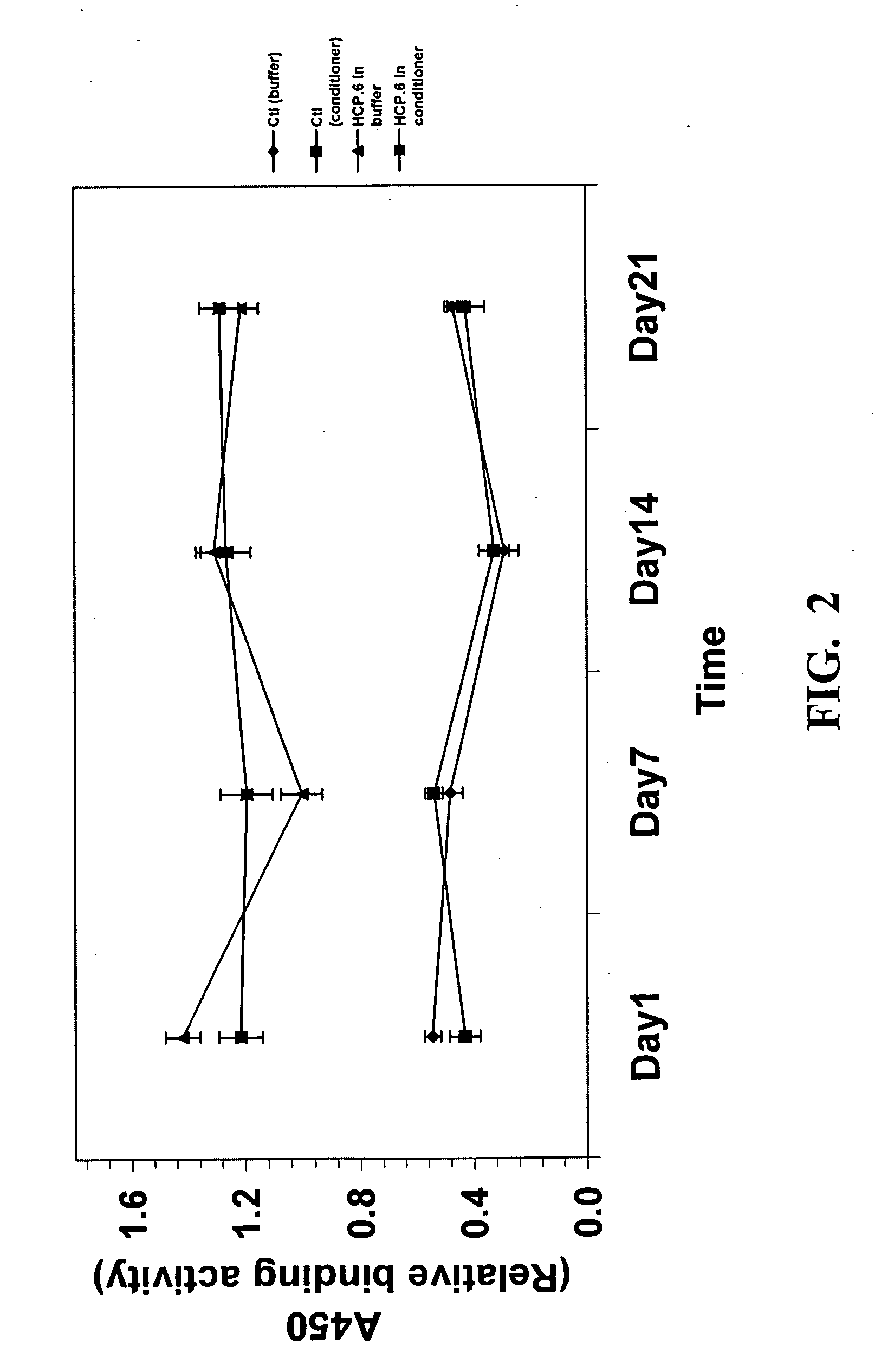Method for identifying hair conditioner-resistant hair-binding peptides and hair benefit agents therefrom
- Summary
- Abstract
- Description
- Claims
- Application Information
AI Technical Summary
Benefits of technology
Problems solved by technology
Method used
Image
Examples
examples
[0184] The present invention is further defined in the following Examples. It should be understood that these Examples, while indicating preferred embodiments of the invention, are given by way of illustration only. From the above discussion and these Examples, one skilled in the art can ascertain the essential characteristics of this invention, and without departing from the spirit and scope thereof, can make various changes and modifications of the invention to adapt it to various uses and conditions.
[0185] The meaning of abbreviations used is as follows: “min” means minute(s), “sec” means second(s), “h” means hour(s), “μL” means microliter(s), “mL” means milliliter(s), “L” means liter(s), “nm” means nanometer(s), “mm” means millimeter(s), “cm” means centimeter(s), “μm” means micrometer(s), “mM” means millimolar, “M” means molar, “mmol” means millimole(s), “μmole” means micromole(s), “g” means gram(s), “μg” means microgram(s), “mg” means milligram(s), “pfu” means plague forming u...
examples 1-3
Identification of Hair Conditioner-Resistant Hair-Binding Peptides
[0192] The purpose of these Examples was to demonstrate the method of identifying hair conditioner-resistant hair-binding peptides, from three random phage display peptide libraries.
[0193] The hair samples used were 6-inch (15 cm) long pieces of medium brown human hairs, obtained from International Hair Importers and Products (Bellerose, N.Y.). The hairs were placed in 90% isopropanol for 30 min at room temperature and then washed 5 times for 10 min each with deionized water. The hairs were air-dried overnight at room temperature. The hairs were cut to a length of 1 cm and 10-20 hairs were placed into a microcentrifuge tube.
[0194] The phage sample, pretreated as described above to remove skin and plastic-binding clones, was added to the tube containing the hair sample and the mixture was incubated at room temperature for 1 h. The phage solution was removed and the hair sample was incubated in undiluted hair conditi...
example 4
Specificity of Hair Conditioner-Resistant Hair-Binding Peptides
[0196] The purpose of this Example was to demonstrate the specificity of the hair conditioner-resistant hair-binding peptides that were identified in Examples 1-3 using an ELISA procedure.
[0197] The hair-binding peptides HCP.1 (SEQ ID NO:1) and HCP.6 (SEQ ID NO:4) were used in this Example along with a control peptide, an unrelated skin-binding peptide, Skin 1 (Huang et al., U.S. Patent Application Publication No. 2005 / 0050656), given as SEQ ID NO:8. All of the peptides were synthesized with an added lysine residue, derivatized with the fluorescent tag 5-carboxyfluorescein-aminohexyl amidite (5-FAM), at the C-terminus by SynPep (Dublin, Calif.). The sequences of the derivatized hair binding peptides HCP.1(5-FAM) and HCP.6(5-FAM) are given as SEQ ID NOs:9 and-10, respectively. The sequence of the derivatized skin-binding peptide control Skin 1(5-FAM) is given as SEQ ID NO:11.
[0198] For the assay, a unique hair or pig s...
PUM
| Property | Measurement | Unit |
|---|---|---|
| Length | aaaaa | aaaaa |
| Fraction | aaaaa | aaaaa |
| Fraction | aaaaa | aaaaa |
Abstract
Description
Claims
Application Information
 Login to View More
Login to View More - R&D
- Intellectual Property
- Life Sciences
- Materials
- Tech Scout
- Unparalleled Data Quality
- Higher Quality Content
- 60% Fewer Hallucinations
Browse by: Latest US Patents, China's latest patents, Technical Efficacy Thesaurus, Application Domain, Technology Topic, Popular Technical Reports.
© 2025 PatSnap. All rights reserved.Legal|Privacy policy|Modern Slavery Act Transparency Statement|Sitemap|About US| Contact US: help@patsnap.com



